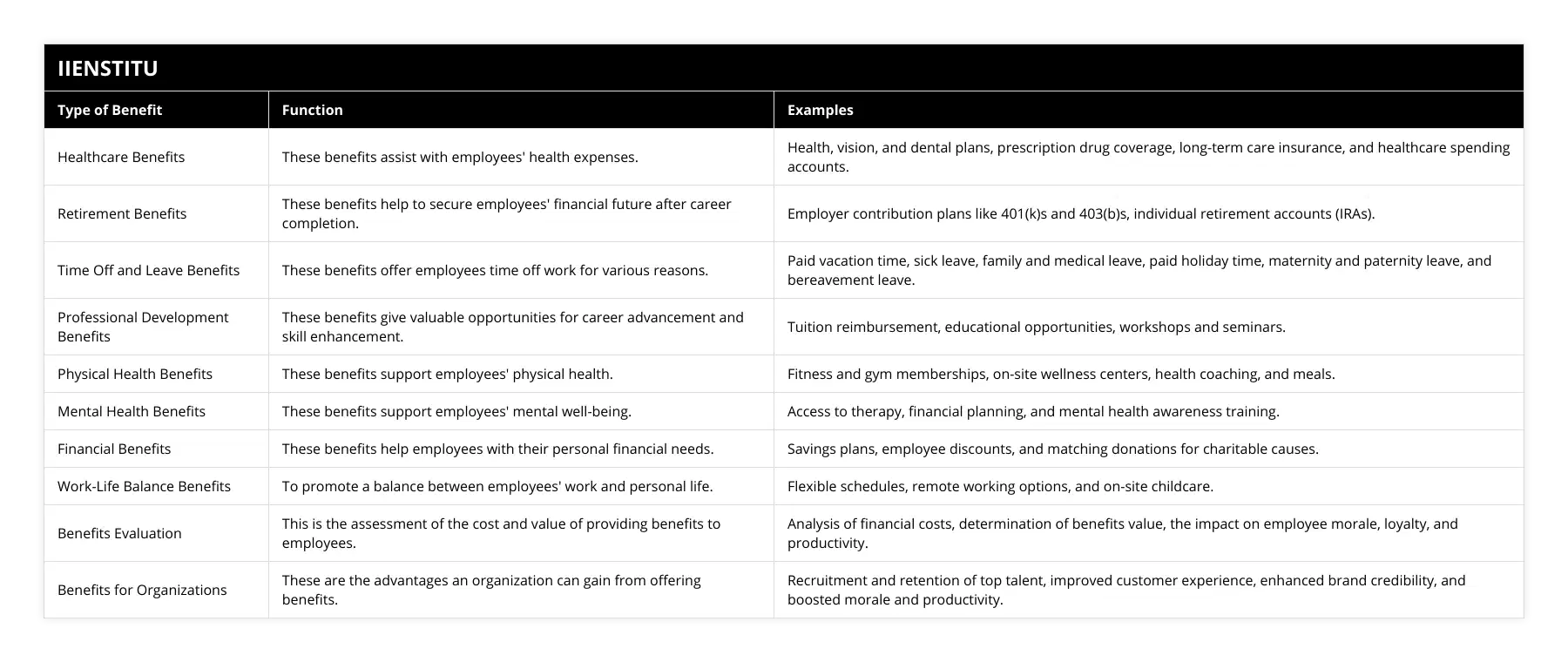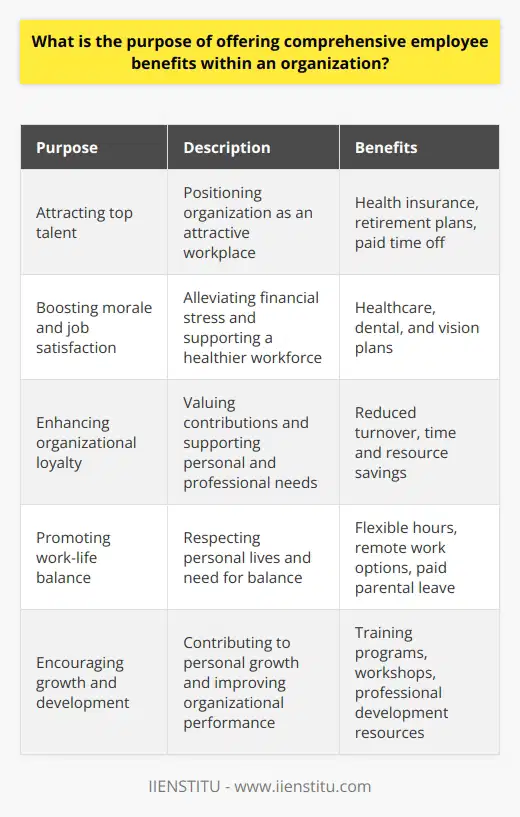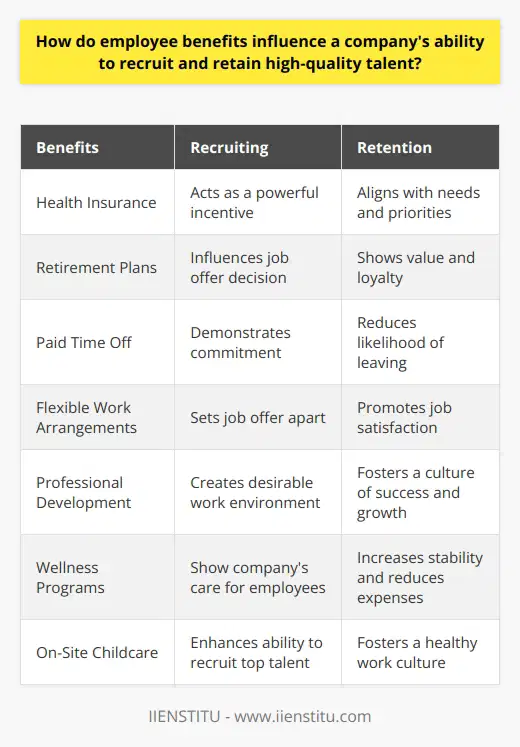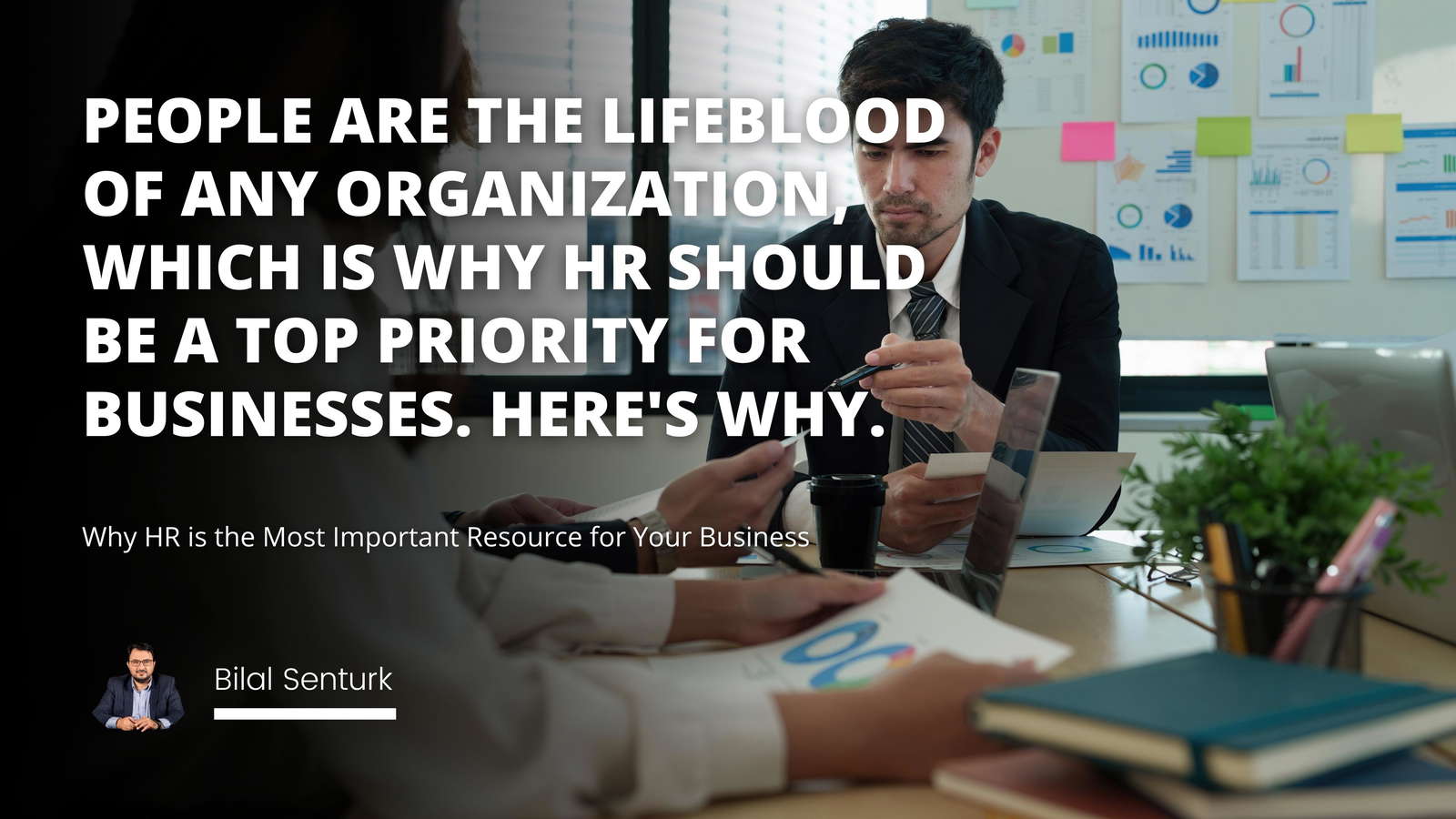
Overview of Employee Benefits
Types of Employee Benefits
Benefits for Employee Well-Being
Evaluating the Cost & Benefits of Employee Benefits
Employee benefits can play an essential role in the success of any organization. Employee benefits attract and retain top talent and can also be a motivating factor when it comes to providing a great customer experience.
In addition, an organization with a comprehensive employee benefits package can also enjoy improved morale among its staff, creating an environment of loyalty and motivation. In this blog post, we’ll explore a comprehensive overview of employee benefits, the goals they can help organizations meet, the different types of benefits associated with employee well-being, and considerations for evaluating the overall value of a benefits package.
Overview of Employee Benefits
Employee or fringe benefits or perquisites are any non-monetary compensation made available to employees as part of their employment agreement. Gifts can come in various forms, including health insurance, retirement plans, time off and leave benefits, and professional development opportunities.
Benefit Goals in Organizations
Organizations provide benefits for various reasons, such as recruiting and retaining top talent and improving customer experience. Gifts also play an integral role in promoting employee well-being and forming a sense of loyalty between the employer and employees. In addition, employee benefits can also add credibility to an organization’s brand and help boost morale and productivity.
Types of Employee Benefits
Organizations may provide various benefits to their employees, depending upon the size and structure of the organization. Some of the most common employee benefits include healthcare, retirement, and time off and leave benefits.
Healthcare Benefits
Healthcare benefits are a common employee benefit and typically range from health, vision, and dental plans, to prescription drug coverage, long-term care insurance, and even healthcare spending accounts.
Retirement Benefits
Retirement benefits are an essential part of any employee’s financial future. Expected retirement benefits may include employer contribution plans such as 401(k)s and 403(b)s and other retirement savings accounts such as individual retirement accounts (IRAs).
Time Off and Leave Benefits
Employees may also have access to time off and leave benefits, such as paid vacation time, sick leave, and family and medical leave. In addition, depending on the organization, employees may also have access to paid holiday time, maternity and paternity leave, and bereavement leave.
Professional Development Benefits
In addition to healthcare and retirement benefits, organizations may also offer employees professional development benefits. This can include tuition reimbursement or other educational opportunities. Professional development benefits can also be career planning or personal development workshops and seminars.
Benefits for Employee Well-Being
In addition to the above, organizations may also provide benefits to promote employee well-being and work-life balance. These are often the most valuable benefits, fostering greater employee engagement and productivity.
Physical Health Benefits
Organizations may offer physical health benefits, such as fitness and gym memberships, on-site wellness centers, health coaching, and sometimes even free meals.
Mental Health Benefits
Mental health benefits are becoming increasingly popular in the workplace, with employers offering resources and support for employees’ mental health needs. This can include access to therapy, financial planning, and mental health awareness training.
Financial Benefits
Organizations may also offer financial benefits, such as savings plans, employee discounts, and matching donations for charitable causes.
Work-Life Balance Benefits
Work-life balance is a significant consideration for employees today. Benefits such as flexible schedules, remote working options, and on-site childcare may be included in a comprehensive employee benefits package.
Evaluating the Cost & Benefits of Employee Benefits
When considering the costs of employee benefits, it’s essential to evaluate both the costs and the value to determine whether the benefits are worth the investment.
Organizations should consider the financial costs associated with each type of employee benefit, such as the cost of health insurance and premiums for retirement plans. Once the charges have been determined, the organization can decide which benefits are the most valuable and cost-effective.
Assessing the Value of Employee Benefits
It is also essential to consider the value of the employee benefit in terms of its impact on employee morale, loyalty, and productivity. In addition, organizations should consider how each gift contributes to the overall success of their organization, as well as the potential value of these benefits in terms of competitive recruitment and retention.
Conclusion: Employee benefits can play an essential role in the success of any organization. Benefits can be a powerful tool in attracting and retaining top talent and boosting employee morale and loyalty while helping organizations reach critical goals such as reducing turnover and increasing customer experience. Organizations should consider the costs and potential benefits of each type of employee benefit and evaluate the value of each benefit to identify the most cost-effective and valuable package to offer their employees.
Investing in employee benefits pays dividends far beyond just wages

Frequently Asked Questions
What are the general types of benefits typically offered by employers to their employees?
Employers often provide their employees with various benefits and amenities that may include substantial compensation. As a result, the types of benefits employers offer will vary depending on their specific objectives. But, generally speaking, there are four significant categories of employee benefits that employers typically provide: financial benefits, health care benefits, retirement benefits, and leave benefits.
Financial benefits may include salaries, bonuses, commissions, and other forms of remuneration. Additional economic benefits may include tuition reimbursement for enrolled employees, employee discounts, and access to company cars.
Health care benefits such as health insurance, vision and dental coverage, mental health and substance abuse coverage, prenatal coverage, and other benefits are significant for many employees. In addition, wellness programs, flu shots, and other preventative health services may also be covered.
Retirement benefits generally refer to those payments made by employers so that employees can maintain their living standards after retirement. These can include contribution-matching to a 401(k) retirement plan and other retirement savings plans such as IRAs, 403(b)s, SEP IRAs, and more.
Finally, leave benefits to refer to paid (or unpaid) leave an employee takes due to illness, vacation, or parental obligations. Such leave benefits help maintain continuity at the workplace, improve job satisfaction and morale, enhance productivity, and provide necessary personal and family time.
In sum, these are the main types of employee benefits that employers typically offer. However, employers should assess their needs and those of their employees to determine what combinations of help they can contribute to creating the most attractive employment package.

How are employee benefits administered and monitored by the employer?
Employee benefits are integral to a company’s reward and recognition program. These benefits help to attract and retain talented employees. They can include health and dental plans, disability insurance, pension plans, and other benefits such as education subsidies, loan programs, and flexible work hours. However, administering and monitoring employee benefits can be a complex task.
The first step in administering and monitoring employee benefits is to ensure they are correctly implemented and maintained. This includes setting up policies and procedures, such as deductibles, plan limits, and enrollment periods, and ensuring the company’s policies are communicated to employees. Additionally, it is essential to ensure that employees properly communicate and acknowledge the benefits.
Next, ensuring that the benefits are regularly tracked and monitored is necessary. This includes verifying that benefits are utilized correctly and that they are meeting the needs of the employees. Additionally, it is essential to follow the financial aspect of the benefits so that employers can verify that the amount of money allocated to the benefits plan is sufficient.
Finally, employers must also ensure their employee benefits comply with applicable regulations. This includes ensuring that the benefits abide by applicable federal, state, or local laws and comply with relevant employment laws, such as the Family and Medical Leave Act and the Americans with Disabilities Act. Additionally, employers must regularly review and update their plans to ensure compliance.
Overall, administering and monitoring employee benefits can be time-consuming, but it is a necessary part of an effective rewards and recognition program. Employers should ensure that their benefits are adequately communicated to employees, that they are tracked and monitored regularly, and that they are compliant with applicable regulations. Employers should also take the time to review and update their benefits plans regularly to stay compliant and ensure that their projects meet the needs of their employees.

Are there any legal requirements that must be adhered to by employers in providing employee benefits?
When employers offer their employees benefits packages, the law requires that specific standards be adhered to. Therefore, employers must ensure that all legal requirements are met when submitting and providing employee benefits. This article will examine the legal requirements employers must adhere to when offering employee benefits.
Employers must ensure that all employees are treated equally, and all benefit offerings must be available to all eligible employees. The United States Equal Employment Opportunity Commission (EEOC) guidelines on benefit offerings state that employers must ensure that all employees are treated equally, regardless of sex, age, race, religion, or national origin. Employers may not differentiate access to benefits or compensation opportunities or discriminate when providing benefits or other compensation-related decisions.
Employers must also ensure that their benefit plans comply with state and federal laws. State and federal laws exist to help protect employees from workplace discrimination and ensure that employers adhere to specific benefit requirements. These laws include the Affordable Care Act, the Consolidated Omnibus Budget Reconciliation Act (COBRA), and the Family and Medical Leave Act (FMLA). Additionally, employers must comply with other state and federal laws that govern employee benefits and compensation, such as the minimum wage, overtime requirements, and insurance coverage.
An employer must also ensure that they correctly classify employees. Generally speaking, employees are classified as either exempt or non-exempt. Exempt employees are not eligible for benefits and other forms of compensation, while non-exempt employees are eligible for benefits and other forms of payment. The Fair Labor Standards Act (FLSA) provides guidelines on how employers classify their employees, and employers must adhere to these guidelines to ensure compliance.
Finally, employers must ensure that all required documentation is completed correctly. This documentation often includes forms related to benefit eligibility, such as health care enrollment forms, disability insurance applications, and pension contributions forms. Employers must adhere to the deadlines for completing these forms and promptly submit the documents to the appropriate agencies.
In conclusion, employers must ensure that they adhere to all legal requirements relating to providing employee benefits. They must ensure that all employees are treated equally when making benefits decisions and that their benefit plans comply with applicable state and federal laws. Employers must also correctly classify employees and ensure all required documentation is submitted to the appropriate agencies within the required timeframe. Failure to adhere to these requirements could result in legal repercussions for the employer.

What is the purpose of offering comprehensive employee benefits within an organization?
Purpose of Comprehensive Employee Benefits
Attracting Top Talent
The primary purpose of offering comprehensive employee benefits within an organization is to attract and retain top talent in the competitive job market. Employers must provide a balance of substantive compensation and valuable perks in order to position their organization as an attractive workplace for prospective employees. A robust benefits package, which may include health insurance, retirement plans, and paid time off, demonstrates a company's commitment to the well-being of its employees and sets the organization apart from its competitors.
Boosting Employee Morale
Another significant reason for offering comprehensive employee benefits is to boost employee morale and job satisfaction. By providing employees with essential benefits such as healthcare, dental, and vision plans, employers can help alleviate financial stress and support a healthier workforce. Since health and wellness directly impact productivity levels, a comprehensive benefits package ultimately contributes to better performance and higher employee engagement.
Enhancing Organizational Loyalty
Comprehensive employee benefits also serve to strengthen organizational loyalty and foster long-term commitment among staff members. When employees feel their employer values their contributions and provides support for their personal and professional needs, they are more likely to remain with the organization for an extended period. Thus, offering generous benefits helps minimize employee turnover, saving the organization both time and resources associated with the recruitment and training of new personnel.
Promoting Work-Life Balance
Another essential reason for offering comprehensive employee benefits is to promote a healthy work-life balance. Benefits such as flexible hours, remote work options, and paid parental leave show that the organization respects the personal lives of its employees and appreciates the need for balance. As a result, employees are likely to be more motivated, focused, and efficient in their work.
Encouraging Employee Growth and Development
Finally, organizations offer comprehensive employee benefits to encourage growth and development among staff members. By providing continuous learning opportunities through training programs, workshops, and access to professional development resources, employers not only contribute to the personal growth of their employees but also to the overall improvement of the organization's performance.
In summary, providing comprehensive employee benefits is vital for attracting and retaining top talent, boosting morale, promoting loyalty, ensuring a work-life balance, and encouraging growth and development. Embracing these purposes not only contributes to the success and sustainability of an organization but also fosters a supportive and nurturing work environment.

How do various employee benefits contribute to the overall well-being and satisfaction of employees in the workplace?
Employee Benefits and Their Impact
Health and Wellness Programs
Employee benefits, such as health and wellness programs, contribute significantly to the overall well-being and satisfaction of employees in the workplace. These programs typically include preventative health screenings, exercise programs, and mental health support, which together help reduce absenteeism, boost morale, and improve overall productivity.
Flexible Work Arrangements
Another powerful contributor to employee well-being is the provision of flexible work arrangements. Offering employees the ability to work remotely, choose their own hours, or take advantage of part-time schedules not only increases job satisfaction, but also reduces stress and enhances work-life balance. Consequently, such arrangements help attract and retain high-quality talent.
Financial Support and Benefits
The overall financial health of employees plays a critical role in workplace satisfaction. Providing competitive salaries, bonuses, and additional financial benefits, such as retirement plans and tuition assistance programs, helps to create a sense of financial stability for employees. In turn, this promotes a positive work environment and fosters long-term commitment to the organization.
Learning and Development Opportunities
When employees have ample opportunities for learning and personal growth, their overall well-being improves. Training programs, professional development courses, and opportunities for internal advancement not only equip employees with new skills and knowledge but also demonstrate an organization's commitment to the growth of its staff. As a result, employees are more satisfied, engaged, and likely to stay with the company.
Workplace Culture and Social Benefits
Lastly, a positive workplace culture that encourages social interaction, teamwork, and open communication contributes greatly to employee well-being. Benefits such as company-sponsored events, team-building activities, and recognition programs help to foster a sense of belonging and teamwork among employees. In turn, this leads to increased job satisfaction and commitment to the organization.
In conclusion, a diverse range of employee benefits contributes significantly to the overall well-being and satisfaction of employees within the workplace. By investing in health and wellness programs, flexible work arrangements, financial support, learning opportunities, and a positive workplace culture, organizations can create a motivated, loyal, and productive workforce.

How do employee benefits influence a company's ability to recruit and retain high-quality talent?
Impact on Recruitment
Employee benefits play a significant role in a company's ability to attract high-quality talent. Competitive benefits packages can serve as powerful incentives for potential candidates when considering job offers. When companies invest in an array of benefits such as health insurance, retirement plans, paid time off, and flexible work arrangements, they demonstrate a commitment to employee well-being. This commitment can make their job offer stand out and potentially sway a sought-after candidate's decision.
Retention of Top Talent
In addition to attracting top talent, employee benefits contribute to the retention of valuable employees. High-quality employees tend to seek out companies that offer benefits packages aligning with their needs and priorities. When individuals feel their employer values their contributions by providing competitive benefits, they are more likely to remain loyal to the company. Furthermore, feeling supported and rewarded for their work fosters a sense of job satisfaction, reducing the likelihood of seeking opportunities elsewhere.
Creating a Desirable Work Environment
A comprehensive employee benefits package can create a positive work environment, further improving an organization's ability to recruit and retain top talent. By offering perks such as professional development, wellness programs, and on-site childcare, companies show they care about the whole employee experience. This focus on employees as individuals fosters a healthy work culture that high-quality talent often seeks.
Cost vs. Value
While employee benefits can incur costs for a company, they provide a valuable return on investment by helping to secure and retain top talent. Offering competitive benefits can also lead to lowered employee turnover, promoting stability and reduced hiring and training expenses. Providing high-quality employee benefits demonstrates a company's commitment to the well-being and success of its workforce, effectively attracting and retaining the best talent available.
In conclusion, employee benefits significantly influence a company's ability to recruit and retain top talent. Offering a comprehensive and competitive benefits package can sway potential candidates to choose a company, while also encouraging current employees to remain loyal. This investment in employee well-being ultimately promotes a desirable work environment, fostering a culture of success and growth.



